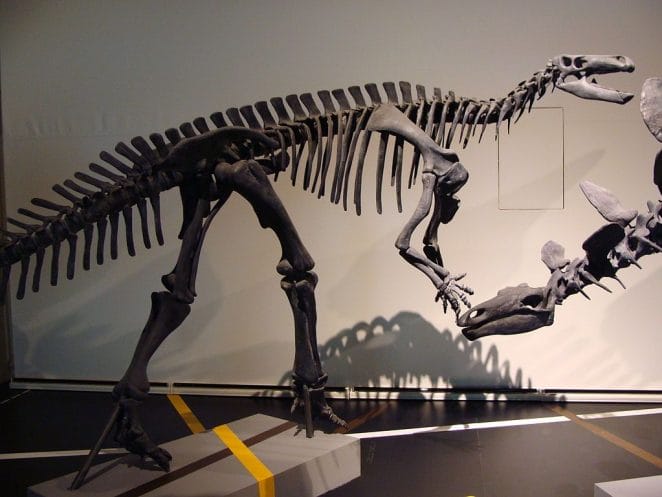Theiophytalia was a herbivorous dinosaur of the Iguanodontia family that lived during the Lower Cretaceous Period in what is now North America. Theiophytalia is only known from a fragmentary skull found in Colorado’s Purgatoire Formation.
Theiophytalia most likely grazed on low shrubs and bushes close to the ground. Theiophytalia was linked to Camptosaurus and was formerly known as Camptosaurus amplus. Kathleen Brill and Kenneth Carpenter conducted a review in 2006, which resulted in the designation of Theiophytalia kerri as a distinct species.

Find out more facts about Theiophytalia.
1: Theiophytalia quick facts:
Name: Theiophytalia (Greek for “Garden of the Gods”); pronounced Thay-o-fy-tal-yah
When it lived: Early Cretaceous, 112 million years ago
Type of dinosaur: Ornithopod
Location: USA
Habitat: Terrestrial habitats.
Length/Weight: 7 meter/750kg
Diet: Herbivorous
Distinguishing Characteristics: Severely roughened front edge of the mouth.
Named by: Brill & Carpenter (2006)
2: How do you pronounce ‘Theiophytalia’?
The name Theiophytalia should be pronounced “Thay-o-fy-tal-yah.”
3: What does the name Theiophytalia mean?
The genus name Theiophytalia is derived from the Greek terms ‘theios’ (meaning ‘divine’) and ‘phytalia’ (meaning ‘garden’ or ‘garden of the gods’).
4: What Did Theiophytalia Look Like?
Theiophytalia was a herbivore of medium size. Theiophytalia skull length is estimated to be 46.6 cm. The skull’s overall traits and size were considered to be midway between Camptosaurus and Iguanodon. It was roughly triangular in the dorsal view, having a small snout and a larger cheek area resembling a Camptosaurus.

Theiophytalia, on the other hand, was proportionally longer than its better famous relative. Similar to Camptosaurus, the nostrils were tiny and positioned near the front of the mouth. The preorbital window was tiny, falling somewhere between the two ornithopods discussed previously. Theiophytalia eye sockets were smaller than those of Camptosaurus, but similar to those of Iguanodon. The significantly roughened front edge of the mouth was one of Theiophytalia’s distinguishing traits.
Sources:Wikipedia





GIPHY App Key not set. Please check settings